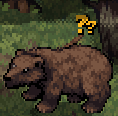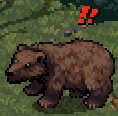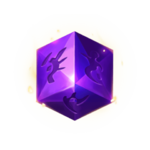Combat/zh
Stoneshard使用基于回合的系统,其中集成了许多支持系统并相互结合。 基本前提是您的角色每进行一回合,所有敌人也会进行一回合。 当前无法获得额外的回合,并且类似地,敌人也无法获得额外的回合。
回合可采取行动
首先你要知道很多行动都会消耗一个回合:
- 移动
- 攻击
- 使用技能 (例如 检查周围环境), 除非另有说明
- 使用物品 (使用 药物,、吃,、喝、picking up loot,、阅读书籍/scroll/日志,、enchanting an item,、鉴别物品, 打开 背包……)
- 打开 容器 (尸体,、墓穴,、箱子、架子、 石柜……)
- 使用物品 (祈祷 祭坛、开门、 接触陷阱)
- 高喊
- 投掷物品
这些操作不会花费一个回合
Alertness
Alertness is the state of NPCs which represents if they know about you. Townspeople don't have alertness, but all other neutral and enemy NPCs do. While the NPCs do react to each other (for example wolves will hunt deer, or wolves and bandits will go kill each other), it doesn't appear that they use the same Alertness system that is used when the player is involved.
Currently there are 3 levels of alertness:
- Unaware
- Suspicious
- Hostile
Levels of Alertness
Unaware NPCs will do their normal things - walk around, sit around the fire, stand ground and guard their area, and so on. They will remain Unaware as long as they don't spot you, hear you or until you hit them with an attack.
Suspicious NPCs will interrupt their normal routine and they will move to the last spot where they saw or heard you. They will remain Suspicious until they come close enough to spot you or until you hit them with an attack, then they become Hostile. If they cannot find you and don't get alerted again for a certain amount of time, they will eventually go back to their Unaware state. Territorial animals - such as Bears, Boars or Wolves - will instead stay on their place and try to scare the player by making specific sound and animation. If the player stays in their close proximity for too long or comes too close, these animals will enter the Hostile state. Otherwise, if player leaves their close proximity quickly enough, the animals will go back to the Unaware state.
Hostile NPCs will move and attack you with melee or ranged attacks, spells and they will use their Skills to charge at you and kill you. They will remain Hostile until killed, or until you manage to outrun them.
There are exceptions to this behavior. For example, if some Suspicious or Hostile NPCs see other NPCs that they would like to fight, they might choose to ignore you and go fight other NPCs instead (for example Bandits vs. Wolves).
Noise and Stealth
Every action you do - moving, attacking, etc. - produces Noise. The items you wear change the amount of Noise Produced. The more Noise you produce, the higher is the chance that an enemy will raise their Alertness from Unaware to Suspicious and come search for you. In addition, some actions seem to always produce Noise, regardless of the items you wear. These are:
- Breaking crates, doors and barrels
- Killing enemies (but not attacking them - need confirmation)
- Shouting
This mechanic also allows you to lure enemies into favorable terrain or narrow passages to gain an advantage for battle.
Your Stealth attribute affects the chance that enemies are able to see you. A knight in full plate is much more likely to be spotted than a rogue wearing cloak and leather boots. It is currently unknown how Stealth works in detail, but Stealth will be subject to changes according to the Development roadmap. Currently, some enemies are able to spot you from several tiles away, while others (like the Bear) need to come really close before becoming Hostile. Hiding behind trees and corners also seems to help avoid being detected.
Playing stealthy is a huge advantage for battle, because all successful melee attacks on enemies that are Unaware or Suspicious are automatically Critical Hits.
Player Character Modes
As you explore the world of Stoneshard, you will find yourself in many different situations - walking through forests, villages, plains, talking with villagers, fighting and resting. To accomodate what's currently happening on your screen, the game has different modes that change how the game behaves. Some of these modes can be activated manually, some will be activated automatically.
Adventure Mode
Adventure Mode is the default mode and your character will return to Adventure Mode when any other mode has been cancelled. When adventuring, you can make unlimited amount of turns. This can be observed when you click with your mouse to move across the screen, your character will move towards the designated tile without stopping. If you happen to see any other NPCs, like people in a Town or deer in the Forest, they will move on their respective routes together with your movement, creating the illusion of fluid movement. In reality, they can still only move as many turns as it took your character to move to the tile you clicked.
If an NPC spots you and becomes Hostile during your movement, you will either continue moving or stop moving, depending on who spotted you.
These NPCs don't interrupt your movement:
- Townspeople, they don't even use Alertness levels.
- Boars, Deer, Foxes, Mooses, Squirrels, Rabbits or Saigas, these are neutral NPCs. When these animals become Hostile, they don't put you into Combat Mode and they run away from you instead of attacking. Rarely, they can still attack you when cornered or when moving very close to you.
Combat Mode
When in Combat Mode, the unlimited amount of movement turns is no longer possible. You can only perform one action at a time, and after each action, all NPCs on the same map will perform their turns before you can turn again. Combat Mode stays active as long as there is a Hostile enemy nearby. Combat Mode stays active even if you switch maps by moving to the edge of a map or by using dungeon entrance or stairs. Combat Mode ends after you kill all nearby Hostile enemies, or after you outrun them. Due to the turn-based nature of combat, the only way to outrun enemies is by using Movement and Charge skills.
All NPCs except the ones mentioned in the previous section will make you enter Combat Mode on becoming Hostile.
While in Combat Mode, you cannot enter Rest mode - the character will inform you that You cannot rest while the enemies are nearby.
Rest Mode
Rest Mode is a mode when your character sits down and rests. Resting is identical to pressing Space to pass a turn repeatedly, but turns are passed automatically until you cancel Rest Mode and turns pass at an increased speed. Rest Mode stays active until cancelled or until an enemy NPC comes nearby and becomes Hostile. Entering Rest Mode lowers your Vision drastically, so be sure to find a safe spot before resting.
Tip: Closing doors of a room or moving up the stairs to a cleared dungeon level is a good way to stay safe while resting.
The default hotkey for rest mode is R.
Attack Mode
By pressing CTRL you can activate or deactivate the Attack Mode. It can be activated both while in Adventure Mode or Combat Mode. While in the Attack Mode, your character will prioritize attacking over moving to or interacting with objects. This way, you can attack not just enemies, but also all decorative objects like benches, tables, statues and all interactable objects, like Containers or Doors.
Stealth Mode
Stealth Mode is currently not available in the game, and there is no information about the effects of Stealth Mode, but it is mentioned in the Stealth attribute description.
Attacking
Let's have a look at how Attacking works. A simplified explanation is that for each attack the game determines an outcome, which can be either a Hit or a Miss. When you score a Hit, you remove X Health from the target. The X is calculated by using your Damage and reducing it by applying the target's appropriate Defenses. However, the mechanics behind this calculation are much more complex than this.
Hit & Miss
To determine if your Attacks overcome the target's Defenses, the game first checks the nature of your attack. Attacks can be
- Weapon attacks - swinging a melee weapon or shooting a ranged weapon, or using a skill that requires an equipped weapon. This also includes weapon attacks that deal magical damage like Arcane damage.
- Spell attacks - using some kind of Sorcery or skill like War Cry.
Weapon attacks use your Accuracy attribute and compare it with your target's Dodge Chance (which is invisible to you).
Example: Let's say I have a 100% Accuracy, but my target has 10% Dodge Chance, that means I have a 90% chance to hit. The game rolls a random number between 1-100 to determine the result and gets 47. Because 47 is lower than my 90, my attack will hit.
Spell attacks will always hit its target, you cannot miss a Fire Barrage for example. It's magic, duh!
Critical Hit & Fumbled Hit
Now that our attack is a Hit, we need to figure out what kind of Hit it was. There are three possible outcomes, and they are tested in this order:
- Critical Hit - is affected by Crit Chance. Critical Hit means you got lucky, hit a vital spot or penetrated target's armor, therefore dealing increased damage.
- Fumbled Hit - is affected by Fumble Chance. Fumbled means you got unlucky, grazed your target, or otherwise failed the attack or spell. In this case, the nature of your attack comes into play again:
- Normal Hit - you got a clean hit and you deal full damage, same as in our simplified example.
Critical Hit
Your normal damage gets multiplied by your Crit Efficiency. If your attack includes a magical component (+8 Fire Damage), the magical part is unaffected by Crit Efficiency.
In addition to dealing more damage, your attack gains a bonus on this critical hit, based on the Weapon type you're using:
- Swords: +100% Bleed Chance. If successful, applies Bleeding for 5-8 turns.
- Axes: +50% Bodypart Damage.
- Maces: +100% Daze Chance. If successful, applies Daze for 3-5 turns.
- Daggers: +220% Critical Damage against unaware targets. Burn 10% of the target’s Max Energy.
- Two-Handed Swords: Cleave through 3 tiles. +125% Bleed Chance. If successful, applies Bleeding for 6-10 turns.
- Two-Handed Axes: Cleave through 3 tiles and deal increased Bodypart Damage.
- Two-Handed Maces: Cleave through 3 tiles and have increased Daze Chance.
- Staffs: Cleave through 3 tiles. Replenish 10% Max Energy.
- Spears: +100% Immobilization Chance.
- Bows: +100% Immobilization Chance.
- Crossbows: +100% Knockback Chance.
Fumbled Hit
- Fumbled Weapon attacks deal half damage. If your attack includes a magical component (+8 Fire Damage), the magical part is unaffected by the fumble.
- Fumbled Sorcery attacks deal full damage, but cost more Energy and receive longer Cooldowns Duration.
If your attack isn't a crit or a fumble, you will hit your enemy for your full damage.
Counter strike
When receiving, dodging or blocking an enemy melee attack, there is a chance of automatically performing a basic attack against the attacker, known as counter strike. This chance is defined by the Counter Chance attribute, which is also present in NPCs. The counter strike triggers the same effects as the regular basic attack, for example, it prolongs the duration and reduces the number of stacks in various stance skills.
Attack of Opportunity
TODO
Defending
With the final result from the attacker's side, we switch to the defender to see how much damage was caused. There are three types of defenses and these are applied in this order:
- Blocking - The defender blocks/deflects incoming attacks, lessening their impact. If the defender has a Shield, they can also Block ranged attacks. Spells cannot be blocked.
- Protection - The defender receives the attack, but its effects are partially or completely negated thanks to the defender's Armor.
- Resistances - The defender is less susceptible to certain damage types, either thanks to Armor (Plate armor is harder to get through), naturally (Bears have thick hides, Fire is less effective if you're Wet) or magically (the Tutorial/Prologue boss was magically strenghtened from the ritual).
Blocking
Block Chance affects whether an attack will be Blocked. If a Block occurs, the incoming damage is reduced by an amount of defender's Block Power, depending on the damage type of the attack. If the attack deals Physical damage, 100% of defender's Block Power is used. If the attack deals Nature damage or Magic damage, only 50% of Block Power is used.
Example: A Necromancer attacks me using the Necromancer Staff. His attack is a Hit, and there is a total of 27 damage going my way, 17 Crushing damage and 10 Unholy damage. I have Blocked the attack and my Block Power is 30.
- I have enough Block Power to completely Block the 17 Crushing damage, which leaves 30-17 = 13 Block Power remaining.
- Since Unholy is a Magic Damage type, my remaining Block Power is only 50% effective, therefore I Block 13/2 = 7 (rounded up) out of the 10 Unholy damage.
Thanks to Blocking, I will take only 3 Unholy damage.
Protection
Protection reduces attack damage each time damage is received. Any Physical damage is reduced by your Protection amount. Nature damage and Magic damage are unaffected by Protection. Protection is a flat amount.
Example: An attack hits me for 17 Crushing damage, but since I'm wearing Armor pieces with a total of 10 Protection I will take only 17-10 = 7 Crushing damage.
Example: An attack hits me for 10 Fire damage. I'm wearing Armor pieces with a total of 10 Protection, but Fire is Nature damage type, so I will still take 10 Fire damage.
Resistances
Resistances are also applied each time damage is received. Each damage type has its corresponding Resistance type which is applied to incoming damage. Resistances are percentages.
Example: An attack hits me for 10 Fire damage. I have the Wet condition from the Rain, which gives me a total 50% Fire Resistance, so I will only take 5 Fire damage.
See Damage for all available damage types. See Attributes for individual Resistance attributes.
Secondary Effects
Attacks don't just reduce the target's health, but can also apply various other effects. These effects can come naturally from your attack, from having beneficial Conditions active or from using Skills. Combining various secondary effects is key to mastering combat in Stoneshard.
There are many various effects. Feel free to look through the different Skills' descriptions.
Secondary Effects can happen when:
- An attack hits, crits, misses or fumbles
- An attack meets certain criteria (target is affected by certain Conditions, attacking kills the target, ...)
- Your attributes meet certain criteria (when energy is below certain threshold, when weapon durability is above certain threshold, ...)
Throwing
Throwing mechanic is planned to be added with the December update.
Any item in the game can be thrown. The resulting distance, the amount and type of damage depend on a thrown item’s weight and material. For instance, if you lob heavy stuff such as Moose Antlers at someone’s head, you’ll deal heavy damage as long as they are not too far away. A Pine Cone, on the other hand, is only good for attracting attention.
The damage for throwing any item is influenced by Perception, Strength, and Agility:
- Strength affects the the distance
- Perception and Agility affect the Hit Chance and Crit Chance
Item Throwing
Certain items have unique properties:
- By throwing a potion at your enemy, you can apply its effect for a quarter of its base duration.
- Clay and glass items shatter into pieces, dealing piercing damage.
- Breaking a bottle of alcohol or oil on an enemy greatly increases their flammability. On top of that, foul liquids getting into their eyes will make it hard to concentrate on combat.
- Highly flammable items (made from cloth or paper) will burn in fire. Pyromancers, watch your flames!
- A heavy enough item can trigger a claw trap or a pressure plate.
- The amount of noise generated by a thrown item depends on its weight and material. The sound of breaking glass will attract much more attention than a tumbling Acorn.
- It’s hard to throw Mugs without spilling their contents.
Weapon Throwing
Weapon throwing uses Weapon Balance instead of weight and material, which combines item weight and its aerodynamic properties. The better the balance, the further and more precise a throw will be, and the more damage it will deal upon connecting.
Weapons that are good for throwing include:
- Daggers
- Axes (small ones)
- Spears (the pointy ones)
Weapons that aren't well suited for throwing include:
- Swords
- Maces
- Two-handed Weapons
Throwing a weapon repeatedly will quickly drain its durability.
本页最后一次更新时间:补丁: Expression error: Unexpected < operator.
| ||||||||||||||||||||||||||||
| |||||


